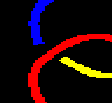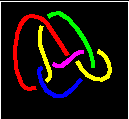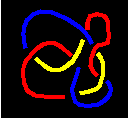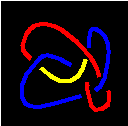
Mathematicians have spent huge amounts of time studying how to color maps and the dots and lines of graphs.
So it's logical to see that mathematicians have also asked, "What interesting things will we discover if we try coloring knots?"




One of these knots is not (knot?) colored according to the rules below. Which one is it?

Here are the coloring rules::
At each crossing you have two choices for the colors of the strands that meet:
Can you use fewer colors with any of the three knots that are colored correctly in the pictures above?
How many colors will you need to use when the knot that is colored wrong is colored right?
Knot theorists are particularly interested in knots that are 3-colorable, which is to say knots that can be colored according to these rules using exactly 3 colors. It turns out that if a knot is 3-colorable, no matter how you deform or redraw the diagram, it will always be 3 colorable.
Do you believe that?
Why do you think it works?
It is also true that if you have two knots and one is 3-colorable and the other one isn't, you can be absolutely certain that it is impossible to twist one of the knots around so that it looks like the other one.
Do you believe that?
Why do you think it works?